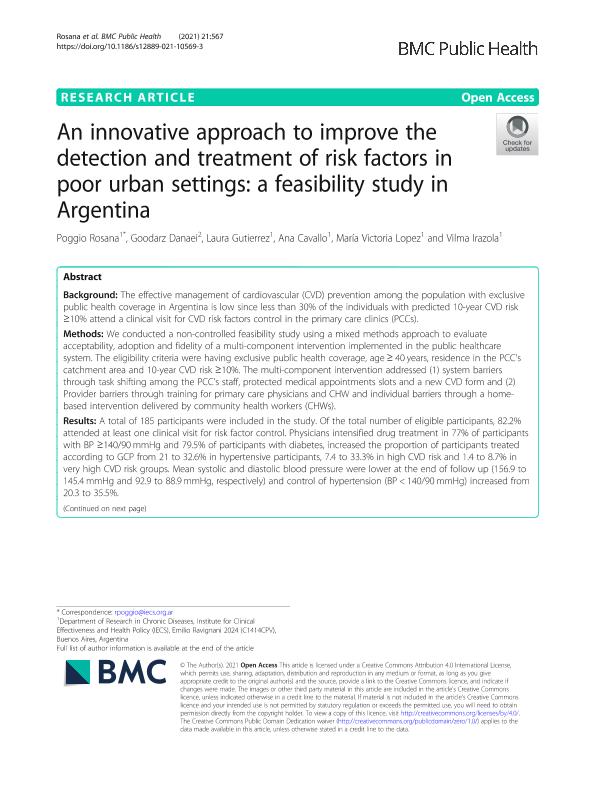Mostrar el registro sencillo del ítem
dc.contributor.author
Poggio, Rosana

dc.contributor.author
Danaei, Goodarz
dc.contributor.author
Gutierrez, Laura
dc.contributor.author
Cavallo, Ana
dc.contributor.author
Lopez, María Victoria
dc.contributor.author
Irazola, Vilma

dc.date.available
2023-01-19T15:44:49Z
dc.date.issued
2021-03
dc.identifier.citation
Poggio, Rosana; Danaei, Goodarz; Gutierrez, Laura; Cavallo, Ana; Lopez, María Victoria; et al.; An innovative approach to improve the detection and treatment of risk factors in poor urban settings: a feasibility study in Argentina; BioMed Central; BMC Public Health; 21; 1; 3-2021; 1-11
dc.identifier.issn
1471-2458
dc.identifier.uri
http://hdl.handle.net/11336/185044
dc.description.abstract
Background: The effective management of cardiovascular (CVD) prevention among the population with exclusive public health coverage in Argentina is low since less than 30% of the individuals with predicted 10-year CVD risk ≥10% attend a clinical visit for CVD risk factors control in the primary care clinics (PCCs). Methods: We conducted a non-controlled feasibility study using a mixed methods approach to evaluate acceptability, adoption and fidelity of a multi-component intervention implemented in the public healthcare system. The eligibility criteria were having exclusive public health coverage, age ≥ 40 years, residence in the PCC’s catchment area and 10-year CVD risk ≥10%. The multi-component intervention addressed (1) system barriers through task shifting among the PCC’s staff, protected medical appointments slots and a new CVD form and (2) Provider barriers through training for primary care physicians and CHW and individual barriers through a home-based intervention delivered by community health workers (CHWs). Results: A total of 185 participants were included in the study. Of the total number of eligible participants, 82.2% attended at least one clinical visit for risk factor control. Physicians intensified drug treatment in 77% of participants with BP ≥140/90 mmHg and 79.5% of participants with diabetes, increased the proportion of participants treated according to GCP from 21 to 32.6% in hypertensive participants, 7.4 to 33.3% in high CVD risk and 1.4 to 8.7% in very high CVD risk groups. Mean systolic and diastolic blood pressure were lower at the end of follow up (156.9 to 145.4 mmHg and 92.9 to 88.9 mmHg, respectively) and control of hypertension (BP < 140/90 mmHg) increased from 20.3 to 35.5%. Conclusion: The proposed CHWs-led intervention was feasible and well accepted to improve the detection and treatment of risk factors in the poor population with exclusive public health coverage and with moderate or high CVD risk at the primary care setting in Argentina. Task sharing activities with CHWs did not only stimulate teamwork among PCC staff, but it also improved quality of care. This study showed that community health workers could have a more active role in the detection and clinical management of CVD risk factors in low-income communities.
dc.format
application/pdf
dc.language.iso
eng
dc.publisher
BioMed Central

dc.rights
info:eu-repo/semantics/openAccess
dc.rights.uri
https://creativecommons.org/licenses/by/2.5/ar/
dc.subject
CARDIOVASCULAR RISK
dc.subject
COMMUNITY HEALTH WORKERS
dc.subject
DIABETES
dc.subject
FEASIBILITY STUDY
dc.subject
HYPERTENSION
dc.subject
IMPLEMENTATION RESEARCH
dc.subject
PRIMARY HEALTH CARE
dc.subject.classification
Otras Ciencias de la Salud

dc.subject.classification
Ciencias de la Salud

dc.subject.classification
CIENCIAS MÉDICAS Y DE LA SALUD

dc.title
An innovative approach to improve the detection and treatment of risk factors in poor urban settings: a feasibility study in Argentina
dc.type
info:eu-repo/semantics/article
dc.type
info:ar-repo/semantics/artículo
dc.type
info:eu-repo/semantics/publishedVersion
dc.date.updated
2022-09-29T13:48:06Z
dc.journal.volume
21
dc.journal.number
1
dc.journal.pagination
1-11
dc.journal.pais
Reino Unido

dc.journal.ciudad
Londres
dc.description.fil
Fil: Poggio, Rosana. Consejo Nacional de Investigaciones Científicas y Técnicas. Oficina de Coordinación Administrativa Parque Centenario. Centro de Investigaciones en Epidemiología y Salud Pública. Instituto de Efectividad Clínica y Sanitaria. Centro de Investigaciones en Epidemiología y Salud Pública; Argentina
dc.description.fil
Fil: Danaei, Goodarz. Harvard University. Harvard School of Public Health; Estados Unidos
dc.description.fil
Fil: Gutierrez, Laura. Instituto de Efectividad Clínica y Sanitaria; Argentina
dc.description.fil
Fil: Cavallo, Ana. Instituto de Efectividad Clínica y Sanitaria; Argentina
dc.description.fil
Fil: Lopez, María Victoria. Instituto de Efectividad Clínica y Sanitaria; Argentina
dc.description.fil
Fil: Irazola, Vilma. Consejo Nacional de Investigaciones Científicas y Técnicas. Oficina de Coordinación Administrativa Parque Centenario. Centro de Investigaciones en Epidemiología y Salud Pública. Instituto de Efectividad Clínica y Sanitaria. Centro de Investigaciones en Epidemiología y Salud Pública; Argentina
dc.journal.title
BMC Public Health

dc.relation.alternativeid
info:eu-repo/semantics/altIdentifier/url/https://bmcpublichealth.biomedcentral.com/articles/10.1186/s12889-021-10569-3
dc.relation.alternativeid
info:eu-repo/semantics/altIdentifier/doi/https://doi.org/10.1186/s12889-021-10569-3
Archivos asociados
